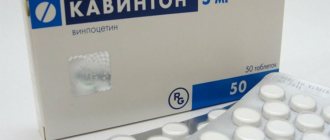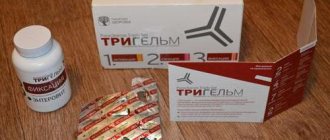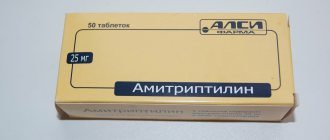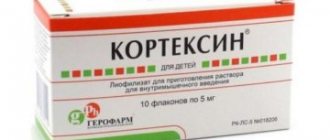Has limitations for kidney problems
Parkinson's disease is a neurological degenerative disease that most often occurs in older people. To date, it cannot be completely cured, but negative symptoms can be relieved with the help of special medications.
Often, for this pathology, medications are prescribed based on the substance levodopa, which, according to the instructions for use, can be used both for Parkinson’s disease and for parkinsonism that has developed as a result of various types of lesions of the central nervous system.
Release form and composition
Levodopa/Benserazide-Teva is available in the form of tablets: pink, round, slightly marbling, with a cross-shaped line on both sides; 100 mg of levodopa – biconvex; 200 mg of levodopa - flat, with a bevel, on one side - in two sections, cross-shaped marks engraved “B” and “L” (20, 30, 50, 60 or 100 pcs. in PVP (high-density polyethylene) bottles) , 1 bottle in a cardboard box).
1 tablet contains the following active ingredients:
- Levodopa – 100 or 200 mg;
- Benserazide – 25 or 50 mg (in the form of benserazide hydrochloride – 28.5 or 57 mg).
Excipients (tablets 100/200 mg, respectively): mannitol - 89.15/178.3 mg, pregelatinized corn starch - 18.7/37.4 mg, microcrystalline cellulose - 4.95/9.9 mg, povidone K25 - 11/22 mg, anhydrous calcium hydrogen phosphate – 7.97/15.94 mg, colloidal silicon dioxide – 0.71/1.42 mg, crospovidone (type A) – 8.25/16.5 mg, red iron oxide dye (E172) – 0.27/0.54 mg, magnesium stearate – 5.5/11 mg.
Pharmacological properties
Pharmacodynamics
The antiparkinsonian drug is a combination of two active components: a dopamine precursor, levodopa, and a peripheral aromatic L-amino acid decarboxylase inhibitor, benserazide.
In patients with Parkinson's disease, the neurotransmitter dopamine is produced in insufficient quantities in the basal ganglia. When using levodopa, a biogenic substance that is a direct metabolic precursor of dopamine, replacement therapy occurs. Since a large proportion of taken levodopa is converted into dopamine in the interstitial tissues of the intestines, liver, kidneys, heart, stomach, peripheral dopamine formed in this way does not take part in the antiparkinsonian effect of levodopa, since it penetrates poorly through the BBB (blood-brain barrier), except Moreover, it is responsible for most of its unwanted effects.
To improve the effect of levodopa, blocking its extracerebral decarboxylation is highly desirable. Due to the administration simultaneously with levodopa of the peripheral decarboxylase inhibitor of aromatic L-amino acids benserazide, which reduces the formation of dopamine in peripheral tissues, firstly, the amount of levodopa entering the central nervous system (central nervous system) indirectly increases, and secondly, the manifestation of undesirable reactions of levodopa is reduced. The combined use of levodopa and benserazide in a 4:1 ratio has the same effect as high-dose levodopa monotherapy.
Pharmacokinetics
- absorption: levodopa and benserazide are absorbed mainly in the upper part of the small intestine. The maximum concentration (Cmax) in plasma after oral administration of the drug is reached after approximately 1 hour. The area under the concentration-time curve (AUC) and Cmax vary in direct proportion to the dose taken. Absorption also depends on intragastric pH and the rate of gastric emptying. The presence of food in the stomach slows down absorption. Taking the drug after meals reduces Cmax in plasma by 30% and increases the time to reach it. The degree of absorption is reduced by 15%. The drug is found in large quantities in the small intestine, kidneys and liver; only about 1–3% penetrates into the brain. The half-life (T1/2) of the drug is approximately 3 hours;
- distribution: levodopa - penetrates the BBB through a saturable transport system, does not bind to plasma proteins, Vd (volume of distribution) is 57 l, AUC in the cerebrospinal fluid is 12% of the plasma value; benserazide – does not penetrate the BBB, accumulates mainly in the small intestine, kidneys, lungs, and liver, penetrates the placental barrier;
- metabolism: levodopa - is metabolized mainly by two main pathways (o-methylation and decarboxylation) and two additional ones (oxidation and transamination). Levodopa is converted into dopamine by aromatic L-amino acid decarboxylase. At the end of this pathway, the main metabolic products are formed - dihydroxyphenylacetic and homovanillic acids. 3-o-methyldopa is formed from levodopa when it is methylated by catechol-o-methyl transferase. This main metabolite has a T1/2 of 15 hours, as a result of which patients who have received therapeutic doses of the drug accumulate it. The use of levodopa with benserazide leads to a decrease in its peripheral decarboxylation, an increase in plasma concentrations of levodopa and 3-o-methyldopa, a decrease in the level of catecholamines (dopamine and norepinephrine), and a decrease in the concentration of phenolcarboxylic acids (homovanillic and dihydrophenylacetic). Benserazide undergoes hydroxylation in the liver and intestinal mucosa to form trihydroxybenzylhydrazine, a metabolite that is a powerful inhibitor of aromatic L-amino acid decarboxylase;
- excretion: T1/2 of levodopa against the background of peripheral inhibition of aromatic L-amino acid decarboxylase is 1.5 hours, its plasma clearance is 430 ml/min; Benserazide is eliminated almost completely by metabolism, its metabolites are mainly excreted by the kidneys - up to 64%, and to a lesser extent by the intestines - up to 24%. Absolute drug accumulation averages 98% (range 74–112%).
Since less than 10% of unchanged levodopa/benserazide is excreted by the kidneys, no dose adjustment is required for mild to moderate renal impairment.
In old age (65–78 years) in patients with Parkinson's disease, T1/2 and AUC of levodopa increase by 25%; these changes are not clinically significant.
pharmachologic effect
Levodopa/benserazide is a combined antiparkinsonian drug containing a precursor and an inhibitor of peripheral aromatic L-amino acid decarboxylase. In Parkinsonism, the neurotransmitter dopamine is produced in the basal ganglia in insufficient quantities. Replacement therapy is carried out by using levodopa, a direct metabolic precursor of dopamine. Most of levodopa is converted to dopamine in peripheral tissues (intestines, liver, kidneys, heart, stomach), which is not involved in the antiparkinsonian effect, since peripheral dopamine does not penetrate the blood-brain barrier (BBB) well, and is also responsible for most of its adverse reactions. Blocking extracerebral decarboxylation of levodopa is highly desirable. This is achieved by the simultaneous administration of levodopa and benserazide, an inhibitor of peripheral aromatic L-amino acid decarboxylase, which reduces the formation of dopamine in peripheral tissues, which indirectly leads to an increase in the amount of levodopa entering the central nervous system (CNS), on the one hand, and, on the one hand, to a decrease manifestations of adverse reactions of levodopa - on the other. A 4:1 combination of these substances is as effective as high-dose levodopa.
Contraindications
- Severe functional disorders of the endocrine system, liver, kidneys;
- Exogenous and endogenous psychoses;
- Glaucoma;
- Impaired function of the cardiovascular system in severe forms;
- Combination therapy with non-selective monoamine oxidase inhibitors, a combination of monoamine oxidase inhibitors type A and B;
- Pregnancy and breastfeeding period;
- Age up to 25 years;
- Women of childbearing age (without the use of reliable contraceptive methods);
- Hypersensitivity to the components of the drug.
Instructions for use Levodopa/Benserazide-Teva: method and dosage
Levodopa/Benserazide-Teva tablets are taken orally, observing intervals with meals (preferably at least 30 minutes before or 1 hour after).
Therapy begins with small doses, increasing them gradually (individually for each patient) until a therapeutic effect is achieved. High doses for simultaneous use of the drug should be avoided.
If levodopa is prescribed for the first time, the initial single dose is 50 mg levodopa / 12.5 mg benserazide, the frequency of administration is 2-4 times a day. If well tolerated, the dose is increased by 50-100 mg of levodopa once every 3 days until a therapeutic effect is achieved.
In the future, dose selection is carried out once a month. The therapeutic effect, as a rule, is observed when taking 200-400 mg levodopa / 50-100 mg benserazide per day (maximum 800 mg levodopa / 200 mg benserazide).
The daily dose should be divided into 4 or more doses (to ensure optimal therapeutic effect). If side effects develop, you need to reduce the daily dose or stop increasing the dose.
Achieving the optimal therapeutic effect usually occurs when taking 300-800 mg levodopa / 100-200 mg benserazide.
For patients who have previously taken levodopa, the use of Levodopa/Benserazid-Teva should begin 12 hours after stopping levodopa. The dose is prescribed at a rate of about 20% of the previous dose of levodopa, which allows maintaining the previously achieved therapeutic effect. Subsequently, if necessary, the dose is increased according to the scheme described for patients who have not previously taken levodopa.
For patients who have previously taken a combination of levodopa with an aromatic L-amino acid decarboxylase inhibitor, the use of Levodopa/Benserazide-Teva should be started 12 hours after stopping the drug. To minimize the decrease in the already achieved therapeutic effectiveness, the previous therapy should be interrupted at night, and Levodopa/Benserazide-Teva tablets should be taken the next morning. Subsequently, if necessary, the dose is increased according to the scheme described for patients who have not previously taken levodopa.
Levodopa/Benserazide-Teva may be prescribed to patients who have previously taken other antiparkinsonian drugs. When an obvious therapeutic effect is achieved, it is possible to review the treatment regimen with a reduction or elimination of the alternative drug.
For severe motor fluctuations, it is recommended to increase the frequency of dosing without changing the daily dose. In elderly patients, the dose is increased more slowly. Experience with therapy in children and adolescents is limited.
No dose adjustment is required for moderate to mild hepatic and renal insufficiency.
The dose should be reduced if spontaneous movements such as athetosis or chorea occur in the later stages of therapy.
With long-term treatment, episodes of “freezing”, the “on-off” phenomenon and weakening of the effect towards the end of the dosage period can be significantly reduced or eliminated by reducing the dose or using the drug more frequently at a lower dose. To enhance the effect of treatment, the dose can be increased again in the future.
If side effects from the cardiovascular system develop, the dose should be reduced.
Pharmacokinetics
Suction.
Levodopa and benserazide are absorbed primarily in the upper small intestine. Cmax when taken orally is achieved after approximately 1 hour. The area under the concentration-time curve (AUC) and Cmax are proportional to the dose taken. Absorption depends on the rate of gastric emptying and on intragastric pH values. The presence of food in the stomach slows down absorption. When levodopa is administered after a normal meal, the maximum concentration of levodopa is 30% less and is reached later. The degree of absorption is reduced by 15%. It is found in large quantities in the small intestine, liver and kidneys, only about 1-3% penetrates the brain. T 1/2 3 hours
Distribution.
Levodopa crosses the BBB via a saturable transport system. It does not bind to plasma proteins. Distribution volume 57 l. The AUC of levodopa in cerebrospinal fluid is 12% of that in plasma.
Unlike levodopa, benserazide does not penetrate the BBB. It accumulates mainly in the kidneys, lungs, small intestine and liver and penetrates the placental barrier. Metabolism. Levodopa is metabolized primarily by two major pathways (decarboxylation and o-methylation) and two additional pathways (transamination and oxidation). Aromatic L-amino acid decarboxylase converts levodopa to dopamine. The main end products of this metabolic pathway are homovanillic and dihydroxyphenylacetic acids. Catechol-o-methyl-transferase methylates levodopa to form 3-o-methyldopa. T1/2 of this main metabolite is 15 hours, and in patients who have received therapeutic doses of the drug, its accumulation occurs. Decreased peripheral decarboxylation of levodopa when administered concomitantly with benserazide results in higher plasma concentrations of levodopa and 3-o-methyldopa and lower concentrations of catecholamines (dopamine) and phenolcarboxylic acids (homovanillic acid, dihydrophenylacetic acid). In the intestinal mucosa and liver, benserazide is hydroxylated to form trihydroxybenzylhydrazine. This metabolite is a potent inhibitor of aromatic L-amino acid decarboxylase.
Excretion.
Against the background of peripheral inhibition of aromatic L-amino acid decarboxylase T1/2 of levodopa 1.5 hours. Plasma clearance of levodopa 430 ml/min. Benserazide is almost completely eliminated by metabolism. Metabolites are excreted mainly by the kidneys (64%) and to a lesser extent by the intestines (24%).
Cumulation.
The absolute accumulation of levodopa in combination with benserazide averages 98% (from 74% to 112%).
Pharmacokinetics in special groups of patients.
Less than 10% of unchanged levodopa/benserazide is excreted by the kidneys, so
in patients with mild to moderate renal impairment
.
In elderly patients (65-78 years old)
with Parkinson's disease, T1/2 and AUC of levodopa increase by 25%, which is not a clinically significant change.
Side effects
During therapy, disorders of various body systems may develop with varying frequencies (very often - not less than 10%; often - not less than 1% and less than 10%; sometimes - not less than 0.1% and less than 1%; rarely - not less than 0.01% and less than 0.1%; very rarely - less than 0.01%, taking into account isolated reports):
- Cardiovascular system: very rarely - arrhythmias, increased blood pressure, orthostatic hypotension (usually weakens after dose reduction); with unknown frequency - “tides”;
- Hematopoietic system: very rarely - transient leukopenia, hemolytic anemia, thrombocytopenia;
- Gastrointestinal tract: very rarely - dryness of the oral mucosa, nausea, diarrhea, vomiting, isolated cases of changes or loss of taste; with unknown frequency - gastrointestinal bleeding;
- Nervous system: often – convulsions, increased manifestations of the “restless legs” syndrome, dizziness, headache, episodes of “freezing”, spontaneous movement disorders (such as athetosis and chorea), weakening of the effect towards the end of the dose, the “on-off” phenomenon; very rarely - episodes of sudden drowsiness, severe drowsiness;
- Subcutaneous tissues and skin: rarely - rash, itchy skin;
- Laboratory indicators: infrequently - an increase in creatinine and urea in the blood, bilirubin concentrations, a transient increase in the activity of “liver” transaminases, alkaline phosphatase, a change in the color of urine to red, darkening when standing;
- Psyche: rarely - moderate delight, increased libido, agitation, insomnia, depressed mood, anxiety, anorexia, delirium, depression, aggression, pathological hypersexuality, tendency to gamble; very rarely – short-term disorientation, hallucinations;
- Other: with unknown frequency - increased sweating, febrile fever.
Adverse reactions
Does Levodopa cause side effects? The instructions for use state that while taking it, a person may experience some undesirable reactions that affect the functioning of all body systems:
- Cardiovascular system: rapid heartbeat, arrhythmia, blood pressure disturbances, orthostatic reactions, fainting, etc.
- Digestive tract: diarrhea, vomiting, dyspepsia, anorexia, constipation, change in taste, dry mouth, gastrointestinal bleeding.
It should also be noted that adverse reactions affecting the functioning of the hematopoietic organs, urinary, respiratory and nervous systems cannot be excluded. Often, while taking this medication, allergic reactions, changes in laboratory parameters and undesirable manifestations on the skin occur.
Overdose
Symptoms of an overdose of Levodopa/Benserazide-Teva are an increase in adverse reactions such as nausea and vomiting, arrhythmia, insomnia, confusion, and pathological involuntary movements. Since absorption of the drug from the gastrointestinal tract occurs slowly, the development of symptoms of overdose may be delayed.
You should perform gastric lavage and use enterosorbents (Polysorb, Smecta, Activated Carbon) to prevent further absorption of the drug in the gastrointestinal tract. In addition, symptomatic therapy is recommended: the use of respiratory analeptics, antiarrhythmic drugs, neuroleptics; control of vital functions.
special instructions
Side effects from the digestive system, which occur most often in the initial stages of therapy, are eliminated to a large extent by taking Levodopa/Benserazide-Teva tablets with a small amount of liquid or food, as well as by slowly increasing the dose. The use of the drug for the treatment of Huntington's chorea and iatrogenic extrapyramidal syndrome is not recommended.
If there is a history of gastrointestinal ulcers, osteomalacia and seizures, the corresponding indicators should be regularly monitored. During therapy, it is necessary to monitor indicators of kidney function, liver function and blood count. Patients with coronary heart disease, myocardial infarction, or a history of cardiac arrhythmias should regularly monitor the electrocardiogram.
Patients with a history of orthostatic hypotension should be under medical supervision, especially at the beginning of therapy.
In diabetes mellitus, it is necessary to frequently monitor the concentration of glucose in the blood and adjust the dose of oral hypoglycemic drugs. During therapy, cases of sudden onset of sleep have been reported, which should be taken into account by patients.
The use of Levodopa/Benserazide-Teva increases the likelihood of malignant melanoma (for patients with malignant melanoma, including a history, taking the drug is not recommended) and compulsive disorders.
Before general anesthesia, therapy should be carried out for as long as possible, with the exception of halothane anesthesia (due to the likelihood of fluctuations in blood pressure and arrhythmia, treatment must be discontinued 12-24 hours before surgery). After surgery, treatment is resumed with a gradual increase in dose.
It is impossible to abruptly stop therapy, as this can lead to “withdrawal syndrome” (in the form of increased body temperature, muscle stiffness, as well as possible mental changes and increased creatinine phosphokinase activity in the blood serum) or akinetic crises (in some cases, in life-threatening forms) . If such symptoms appear, the patient should be under medical supervision (hospitalization is possible if necessary) and receive appropriate therapy, which may include re-prescribing Levodopa/Benserazide-Teva.
Depression can be a clinical manifestation of the underlying disease (parkinsonism) or develop during the use of the drug. For the timely detection of adverse mental reactions, the condition of such patients should be monitored.
In some cases, the appearance of cognitive and behavioral disorders associated with uncontrolled use of increasing doses of the drug and a significant increase in therapeutic doses is noted.
Impact on the ability to drive vehicles and complex mechanisms
If excessive daytime sleepiness or sudden sleep episodes develop during therapy, you should stop driving or operating machinery. If these symptoms occur, consider reducing the dose or discontinuing the drug.
Clinical trial results can often lead practitioners down the wrong path. Incorrect interpretation of studies and the lack of their pathophysiological context form myths about drug therapy, which, moreover, comply with the principles of evidence-based medicine. This article provides an overview of three such myths associated with the side effects of taking levodopa in Parkinson's disease.
Introduction
Parkinson's disease is one of the common neurological disorders, a chronic progressive disease that develops due to the degeneration of dopaminergic neurons in the substantia nigra of the brain. The cause of early disability in patients with Parkinson's disease is a combination of symptoms such as motor disorders (hypokinesia, muscle rigidity, tremor), autonomic and mental manifestations. Moreover, the latter usually occur at advanced stages of the disease and are associated with the involvement of the body’s non-dopaminergic regulatory systems in the pathological process. Clinical manifestations of the disease are associated with a neurotoxic effect: with the progression of the degenerative process, the protein alpha-synuclein accumulates in the cells of nerve structures, which has a toxic effect and causes dysfunction, first of the peripheral and then of the central nervous systems [1].
In addition to Parkinson's disease itself, it is customary to distinguish the concept of parkinsonism syndrome, which occurs in other neurodegenerative conditions; Parkinson's disease can thus be considered an idiopathic variant of the syndrome. Variants of parkinsonism include, for example, progressive supranuclear palsy. Parkinsonism syndrome has some clinical differences from Parkinson's disease, such as rapid progression of the disease, early onset of postural instability, pyramidal and cerebellar signs, early development of dysarthria, dysphagia and contractures.
One of the most effective drugs in the treatment of Parkinson's disease, according to the ELLDOPA study, is levodopa, or 3-hydroxy-L-tyrosine [2]. Levodopa is a precursor of dopamine, replacing its deficiency in brain structures. Other antiparkinsonian drugs (dopamine receptor agonists, monoamine oxidase type B inhibitors, catechol-O-methyltransferase inhibitors) have significantly less effectiveness, but are sometimes prescribed instead of levodopa, as it turns out, often due to fear of developing side effects. The most frightening of these effects are two conditions: drug-induced dyskinesia and motor fluctuations.
Dyskinesia is involuntary movements in various muscle groups - a motor disorder that, at first glance, seems extremely undesirable in patients with Parkinson's disease. Motor fluctuations are fluctuations in the effect of levodopa that occur when the next dose of the drug wears off. The occurrence of motor fluctuations is associated with the short half-life of levodopa, which forms stimulation of dopamine receptors that is uneven in intensity. With time of taking levodopa, such fluctuations become quite sharp and are manifested by the unpredictable appearance and disappearance of motor symptoms of the disease, which are called “off” and “on” periods, respectively.
The side effects described seem really scary, but it turns out that there are a lot of misconceptions around them, often preventing patients with Parkinson's disease from receiving effective and reasonable treatment. The authors of the material selected three common myths about taking levodopa, each of which was debunked [3].
Myth 1: Taking levodopa causes dyskinesia.
It is easiest to take the wrong path in this case, because dyskinesia is often found in patients taking levodopa. Studies have noted that the development and severity of dyskinesia positively correlates with the dose of levodopa taken, but the latter is in this case an important and not a key factor in the development of motor disorders. A combination of three factors plays a role in the formation of dyskinesia: Parkinson’s disease itself, levodopa intake and its delivery mechanism. The first condition is supported by the fact that levodopa does not cause dyskinesia in parkinsonism caused by other neurodegenerative conditions. In the context of the method of delivery of the active substance, it is known that the combination of levodopa-carbidopa (in Russia - the drug Duodopa), which enters the body through intestinal infusion in the form of an intestinal gel, does not cause drug-induced dyskinesia and reduces the severity of existing hyperkinesis. This is achieved by providing constant, moderate stimulation of dopamine receptors. Thus, we can conclude that the dyskinesia that occurs when taking levodopa is more likely related to the method of drug delivery than to its direct effect. A more precise definition of this phenomenon is levodopa-associated rather than drug-induced dyskinesia [4].
Myth 2: dopamine receptor agonists delay the development of dyskinesia compared to levodopa
In the treatment of Parkinson's disease, there is the concept of “peak dose” dyskinesia. This is a manifestation of super-strong stimulation of dopamine receptors at the height of the action of a single dose of levodopa, in which hypokinesis, characteristic of parkinsonism, is replaced by hyperkinesis. Peak dose dyskinesia (as well as other patterns of drug-induced dyskinesia) demonstrates the effectiveness of the treatment, but is an undesirable effect. That is why clinicians often motivate the non-prescription of levodopa by the desire to “delay” the onset of dyskinesias. Such beliefs are built around another myth about levodopa.
As already mentioned, other antiparkinsonian drugs, including dopamine receptor agonists, often do not achieve the effectiveness of levodopa even at the maximum tolerated doses. Related to this is the fact that such drugs do not “postpone” the development of dyskinesia, but rather are unable to cause it. Since the development of dyskinesia begins with the onset of Parkinson's disease, and not with the start of taking levodopa, deliberately delaying the administration of the latter has no practical significance. Dyskinesia in patients with Parkinson's disease can still occur, but in the case of taking levodopa, drug dyskinesia will indicate the effectiveness of the drug, whereas in the absence of levodopa, the development of the disease can lead to much more severe consequences.
A large study comparing patients with Parkinson's disease taking and not taking levodopa confirmed the great importance of this drug in improving quality of life, even despite the occurrence of dyskinesia in patients. According to this study, most patients eventually switch to levodopa or add it to existing therapy to improve symptom control. Only 2% of patients taking levodopa discontinue treatment due to side effects; in the group of patients taking dopamine receptor agonists and MAO type B inhibitors, they were 28% and 23%, respectively. It is becoming clear that despite the reduction in the incidence of drug-induced dyskinesia, antiparkinsonian drugs without levodopa can cause other, non-motor disorders, which, coupled with the insufficient effectiveness of these drugs, become the basis for changing therapy to levodopa [5].
Myth 3: motor fluctuations and levodopa use
This myth is based on before-and-after studies of levodopa, which demonstrate dose-dependent changes in motor function and the number of off periods in patients with different treatment options. In the mechanism of occurrence of motor fluctuations, it is important to understand the following: the presence of a period of “off”, that is, the appearance of motor symptoms of Parkinson’s disease, indicates the effectiveness of therapy, that is, the presence of a previous episode of “on” with optimal control of motor functions. Patients taking low doses of levodopa who do not have off periods are likely to have no on periods, so the dose they are taking may not be effective. That is why one of the clinical tactics “start taking levodopa as late as possible and in as low doses as possible” turns out to be completely wrong. Instead of levodopa in this case, other antiparkinsonian drugs are often prescribed; however, the ineffectiveness of such a technique has already been discussed above. The withdrawal of levodopa is essentially unacceptable for a disease that requires replacement therapy - just as it would be incorrect not to prescribe insulin for type 1 diabetes. Without the correct amount of levodopa, patients live with greater disability and poorer quality of life [3].
Thus, it is important to understand that therapy for Parkinson’s disease with levodopa, despite the existing picture of side effects, is irreplaceable in its effectiveness. The associated conditions that arise demonstrate the pathophysiological effects of the drug and in the long term are not as disabling and reduce the quality of life as the non-motor consequences of the progression of the pathology. Doctors and patients must be properly informed about the possible consequences of taking levodopa, because only with reasonable, sufficient therapy will full therapeutic control of Parkinson's disease be possible.
Sources:
- Alpha-synuclein in Parkinson's disease. / Leonidas Stefanis. // Cold Spring Harb Perspect Med. - 2012. - Vol. 2, No. 2.
- Symptomatic pharmacological therapy in Parkinson's disease. / The National Collaborating Center for Chronic Conditions. - London: Royal College of Physicians - 2006. - p. 59–100.
- Common myths in the use of Levodopa in Parkinson disease: when clinical trials misinform clinical practice. / Espay AJ, Lang AE. // Jama Neurol. — 2020. — Vol. 74, no. 6. - p. 633-634.
- Effect of levodopa-carbidopa intestinal gel on dyskinesia in advanced Parkinson's disease patients. / Antonini A, Fung VS, Boyd JT. // Mov Disord. — 2020. — Vol. 31, No. 4. — p. 530-537.
- Don't delay, start today: delaying levodopa does not delay motor complications. / Fox SH, Lang AE. //Brain. — 2014. — Vol. 137. - p. 2628-2630.
Drug interactions
When Levodopa/Benserazide-Teva is co-administered with certain medications, the following effects may occur:
- Trihexyphenidyl (m-anticholinergics): reducing the rate (but not the extent) of absorption of levodopa;
- Ferrous sulfate: decrease in Cmax (maximum concentration of the substance in the blood) and AUC (total concentration of the substance in the blood plasma) of levodopa;
- Antacids: decreased absorption of levodopa/benserazide;
- Non-selective monoamine oxidase inhibitors, a combination of selective monoamine oxidase inhibitors type A and B: development of hypertensive crisis (the combination is contraindicated, a break of at least 14 days must be observed);
- Metoclopramide: increases the rate of absorption of levodopa;
- Opioids, antipsychotics, antihypertensive drugs containing reserpine: suppression of the effect of levodopa/benserazide (the lowest doses of these drugs should be used);
- Pyridoxine: reducing the antiparkinsonian effect of levodopa/benserazide;
- Selective monoamine oxidase inhibitors type A and B (rasagiline, selegiline, moclobemide): increased effect of levodopa/benserazide, no dangerous interaction identified;
- Antihypertensive drugs: development of orthostatic hypotension;
- Sympathomimetics (amphetamine, norepinephrine, epinephrine, isoproterenol): potentiation of their action (the combination is not recommended, if simultaneous use is necessary, the state of the cardiovascular system must be carefully monitored, the dose of sympathomimetics is reduced if necessary);
- Other antiparkinsonian drugs (anticholinergic drugs, dopamine receptor agonists, amantadine): increased therapeutic and undesirable effects (dose adjustment of levodopa/benserazide or other drug may be required);
- Catechol-O-methyltransferase inhibitor: monitoring is necessary, dosage adjustment of levodopa/benserazide may be required;
- Halothane anesthesia: development of arrhythmia and fluctuations in blood pressure (therapy with Levodopa/Benserazide-Teva should be discontinued 12-48 hours before surgery);
- Protein-rich foods: decreased therapeutic effect of the drug.
Levodopa/Benserazide-Teva may affect laboratory results of creatinine, catecholamines, glucose, uric acid, bilirubin, and alkaline phosphatase. It is possible to detect an increase in the concentration of creatinine and urea in the blood, a false positive result of the Coombs test, a false negative reaction to glucose in the urine when determined using the glucose glucose oxidase method.
Dosage
The drug should be taken orally, if possible, at least 30 minutes before or 1 hour after meals.
Treatment begins with a small dose, gradually increasing the dose for each patient individually until a therapeutic effect is achieved. High doses should be avoided when taking the drug simultaneously. The following dosage regimen instructions should be considered as general recommendations.
For patients who have not previously taken levodopa, an initial dose of 50 mg levodopa / 12.5 mg benserazide 2-4 times a day is prescribed (from 100-200 mg levodopa / 25-50 mg benserazide per day). If well tolerated, the dose is increased by 50-100 mg levodopa/12.5-25 mg benserazide every 3 days until a therapeutic effect is achieved.
Further (after the initial) dose selection is carried out once a month. Typically, a therapeutic effect is observed when taking 200-400 mg of levodopa / 50-100 mg of benserazide per day.
The maximum daily dose is 800 mg levodopa/200 mg benserazide.
The daily dose should be divided into 4 or more doses. The frequency of doses should be distributed to ensure optimal therapeutic effect. If adverse reactions occur, it is necessary to either stop increasing the dose or reduce the daily dose.
The optimal therapeutic effect is achieved, as a rule, by taking 300-800 mg of levodopa / 100-200 mg of benserazide.
For patients who have previously taken levodopa, Levodopa/Benserazide-Teva should be started 12 hours after stopping levodopa. The dose of the drug should be approximately 20% of the previous dose of levodopa in order to maintain the already achieved therapeutic effect. If necessary, the dose is increased according to the scheme described for patients who have not previously taken levodopa.
For patients who have previously taken levodopa in combination with an aromatic L-amino acid decarboxylase inhibitor, Levodopa/Benserazide-Teva should be started 12 hours after discontinuation of levodopa in combination with an aromatic L-amino acid decarboxylase inhibitor. To minimize the decrease in the already achieved therapeutic effectiveness, it is necessary to stop the previous therapy at night and start taking the drug Levodopa/Benserazide-Teva the next morning. If necessary, the dose is increased according to the scheme described for patients who have not previously taken levodopa.
Patients who have previously taken other antiparkinsonian drugs can take Levodopa/Benserazide-Teva. As soon as the therapeutic effect of Levodopa/Benserazide-Teva becomes apparent, it is necessary to reconsider the treatment regimen and reduce or discontinue the alternative drug.
Dosage regimens in special cases
For patients who experience severe motor fluctuations, it is recommended to take the daily dose more than 4 times a day without changing the daily dose itself. In old age, dose increases should occur more slowly. Experience with children and adolescents is limited.
For mild to moderate renal and liver failure
no dose adjustment is required.
If spontaneous movements such as chorea or athetosis appear in the later stages of treatment, it is necessary to reduce the dose.
With long-term use of the drug, the appearance of episodes of “freezing”, weakening of the effect towards the end of the dose period and the “on-off” phenomenon can be eliminated or significantly reduced by reducing the dose or using the drug in a lower dose, but more often. Subsequently, the dose can be increased again to enhance the effect of treatment.
If adverse reactions from the cardiovascular system occur, it is necessary to reduce the dose.
Reviews of Levodopa/Benserazid-Teva
In the treatment of Parkinson's disease, according to reviews, Levodopa/Benserazide-Teva acts differently on all patients. Sometimes, with prolonged use, even under medical supervision, patients experience increased irritability and attacks of aggression, and often hallucinations. In some patients, dose reduction relieves symptoms of mental disorders without affecting motor function. At the same time, in other patients, reducing the daily dose or stopping drug therapy can not only preserve existing mental disorders, but can also worsen motor function. Therefore, experts recommend that when starting to take the drug, expect possible severe side effects and be patient to select the optimal dose. Treatment is recommended to be carried out exclusively under the supervision of a doctor, which will allow taking into account the slightest changes in the psyche or cardiovascular system in the patient’s condition and responding to them in a timely manner.









